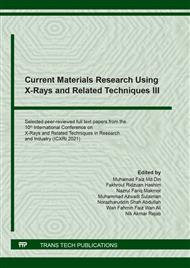p.467
p.473
p.481
p.487
p.494
p.503
p.509
p.517
p.526
Malaysia’s Rare Earth Element Story: Characterizing the "Amang"
Abstract:
Amang is known as a waste product after extraction of tin oxide (cassiterite, SnO2) from its ore. Not long ago, in Malaysia, these tin ore tailings were left in abundance after long years of mining activities. Little had it been realized then, of the importance and future economics of the heavy minerals present in these tailing ‘deposits’ may offer. It is known that the heavy minerals from amang contained rare earth elements that are beneficial in various applications in different types of industries, such as monazite ([Ce, La, Nd, Gd, Th] PO4), zircon (ZrSiO4), ilmenite (FeOTiO2), xenotime (YPO4) and struverite (NbTaTiO2). This paper looks briefly in Malaysia’s REE story and the contents of amang, that makes the story. Amang samples from Kinta Valley were chosen to be characterized, being reminiscent of the country’s REE exploits. Mineral characterization were achieved via various equipment and techniques; this includes utilizing Scanning Electron Microscopy (SEM) with Energy Dispersive X-Ray spectroscopy (EDX), X-ray Fluorescence (XRF) and X-ray diffraction (XRD) techniques, to determine (amongst others) surface morphology and morphological element/mineral identification, chemical element identification and mineral phases present, respectively. Mineralogical studies were also done by scrutinizing polished sections, interpreted under the reflected-light microscope and SEM/EDX, providing more insight into the mineral distribution in the amang and the possibility of liberation. All analyses were done at different size fractions for good comparison with possible indication of ample physical processing, before any proposed chemical processing can take place. Results showed that the chemical and phase constituents in amang were conclusively identified, with the complex distribution of mineral phases reaching 80% liberation at sizes below 125 μm.
Info:
Periodical:
Pages:
494-502
Citation:
Online since:
January 2022
Authors:
Keywords:
Price:
Сopyright:
© 2022 Trans Tech Publications Ltd. All Rights Reserved
Share:
Citation:


